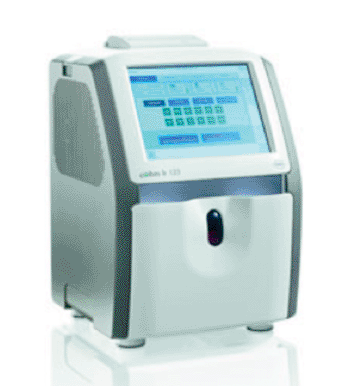Clot Protection Benefits Evaluated for New Blood Gas Testing System
By LabMedica International staff writers
Posted on 12 Sep 2012
The clot protection capabilities of a new blood gas testing system have been highlighted in an evaluation undertaken at a hospital intensive care unit.Posted on 12 Sep 2012
Blood sample clotting is a main concern in point-of-care (POC) testing systems (particularly in neonates for whom blood gases are the most common test performed) and can lead to delayed results and treatment, inconvenient analyzer downtime, and increased work and stress for hospital staff. At the intensive care unit of Stepping Hill Hospital of Stockport NHS Foundation Trust (Stockport, UK), 175 patient samples, including about 30 considered “high risk” for clotting, were analyzed in an evaluation of the new “Roche cobas b 123 POC” system from Roche Diagnostics (Basel, Switzerland). The tests were performed by nursing staff; quality control testing was performed automatically by AutoQC twice daily.

Image: The Roche cobas b 123 POC blood gas testing system (Photo courtesy of Roche Diagnostics).
“We never had a problem with clots throughout the entire evaluation, despite using a wide variety of samples of varying condition and age,” said Samantha Ekin, Point of Care Coordinator (PCC) at the Trust. “This will be vital in a delivery suite setting where the quality of samples can be lower. The small size of the analyzer is great as it can be housed more easily, and it is portable.”
The cobas b 123 is specifically designed to eliminate risk of clot blockages. A new clot clearance feature prevents movement of clots from the syringe or capillary into the analyzer. This is achieved using a dual-action preanalytical barrier, with bottlenecks in the sample port needle and the cooximetry measuring chamber, so that clots are simply rinsed away with the sample by the automated default washing routine. Built-in optical sensors detect whether the lack of fluid path flow is due to a clot, in which case a series of automated expulsion steps remove the clot before continuing analysis uninterrupted.
To date, in both internal and external ongoing evaluations, no downtime owing to clots has been reported for the Roche cobas b 123 POC. The system is very easy to use and requires very little maintenance. “The whole process of analyzing a patient sample was very easy for the operator,” PPC Ekin continues; “This is very important because if the nurses like the analyzer they will have confidence to use it and confidence in the results. The low maintenance is also extremely important, especially for ‘out of hours’ work, as it enables the operators to perform any maintenance that might be required.” She adds that since training is very simple and requires less time, the procedure would be more accessible to additional staff.
Related Links:
Roche Diagnostics
Stockport NHS Foundation Trust










 (3) (1).png)



